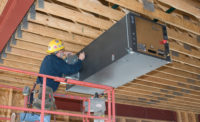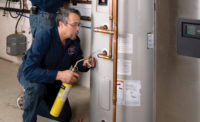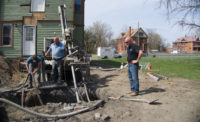While many state and local building codes in the U.S. include design, installation, and commissioning best practices and requirements for new geothermal systems, the country has been lacking a unified standard that brings all of that information together into one place — until now. CSA Group, in partnership with the Geothermal Exchange Organization (GEO) and other industry stakeholders from the U.S. and Canada, recently released the binational 2016 edition of its ANSI/CSA C448 standard for the design and installation of ground-source heat pump systems for commercial and residential buildings.
A BINATIONAL STANDARD
As the first of its kind in the U.S., the standard outlines requirements and best practices for geothermal project design, installation, commissioning, and more in the U.S. and Canada.
“It’s almost cradle to grave,” said Muktha Tumkur, project manager for CSA Group. “It covers everything from design to decommissioning. Even with the 2013 edition, there were a lot of gaps because we hadn’t included details specific to sizing or decommissioning requirements at the end of the life of the units. So, as we worked with the U.S. stakeholders, we incorporated those elements.”
Doug Dougherty, president and CEO of the Geothermal Exchange Organization (GEO), said the organization is quite pleased with the new standard. “We were approached by CSA, and they said the next step would be the standards for the actual installation,” he said. “They said they’d like to do a binational North American standard for Canada and the U.S., and we said we’d support that. So, we promoted their efforts and helped them get funding for it.”
Because of the complexity of the geothermal industry, it’s important to have training materials and standards that are agreed to by everyone, he added. “It’s an accepted standard the industry can use and reference. That’s where we get uniformity of public policy. That’s why we support this.”
Other industry organizations in the U.S. supported the group’s efforts, as well, Tumkur said. “The International Ground Source Heat Pump Association [IGSHPA] was very pleased the document included the material it did. We incorporated much of IGSHPA’s guidelines in the work, and they’re in the process of revamping their training materials to reference a lot of our material in C448. We’ve got the industry behind us.”
GEO GENESIS
While the standard has existed in Canada since 2002, it is new this year in the U.S.
“As we were closing out the 2013 edition, we heard from stakeholders who said they wish we had a standard like this in the U.S., which indicated to us a need. So, shortly after that, we did a public consultation to identify any interested stakeholders if we were to embark upon this as a binational standard, and there was a lot of interest, so we knew we were on the right track,” Tumkur said. “It provides information on how to size the unit, given the application, as well as specific requirements for the different types of installations, and there are key needs that are required in terms of actually installing these systems. As you can imagine, with the types of drilling involved in this industry, there are a lot of environmental stakeholders that are concerned if it’s not done properly. So, we included key elements of concern for those regulators and those stakeholders within the standards, as well, and we cite a lot of work from the National Ground Water Association [NGWA] in that respect. We also include some startup and commissioning requirements to make the whole process smooth. And, what do you do with the boreholes when it’s decommissioned? We include requirements for that with respect to any leaking.”
The standard is quickly gaining recognition in the U.S., which is the result of concerted teamwork between stakeholders from the two neighboring countries.
“The one thing to expand on what [Tumkur] said is that, in many instances, when a standards development organization embarks on a harmonization effort, it’s another organization in the U.S. that brings together the requirements and stakeholders,” said Cliff Rondeau, program manager, CSA Group. “In this instance, however, we developed the requirements on both sides of the border — we actually had one committee that had experts from both sides. To bring everybody to consensus using one committee under one organization was a pretty ambitious undertaking. It really was a binational effort.”
That cooperation has helped ensure the standard is relevant for designers, installers, and end users in both the U.S. and Canada.
“There are definitely design and installation requirements that existed in the U.S.,” Tumkur said. “It’s a technology that’s used in both countries, and what makes this unique is that it brings all this information under one cover. And, some of the material that did exist in the U.S. was not necessarily put through a consensus process like the ANSI [American National Standards Institute] process. So, the key part of the whole project was to bring together the stakeholders who were involved in this industry and supportive of our work.”
THE NEXT STEPS
Due to the timing of the standard’s release, Tumkur said C448 could not be included in the most recent International Code Council (ICC) standards, though CSA is looking into alternatives in the meantime.
“We’ve published it, so now it’s really up to the local authorities having jurisdiction to actually reference our document,” she said. “We missed the window of opportunity for the ICC, so we are considering submitting a proposal that our C448 be referenced in ASHRAE Standard 189.1, which becomes the content of the International Green Construction Code [IgCC], a publication of the ICC. In Canada, the National Building Code references the 2013 edition, but doesn’t yet reference the 2016 version because we’ve just released it. So, we’re waiting for them to consider and possibly incorporate it into the Canadian building code.”
Ryan Carda, president of Geo-Connections Inc., a geothermal software design company, said he anticipates the new standard will absolutely benefit the American geothermal industry.
“This standard makes the technology more approachable, which not only benefits our company but the industry as a whole,” he said. “Everything becomes universal — from products and terminology to the design and installation methods being used. It will serve as a great starting point for information for anyone looking to get involved in the design or installation of these systems at some level.”
To learn more about ANSI/CSA C448, visit http://bit.ly/CSA448
Publication date: 5/2/2016
Want more HVAC industry news and information? Join The NEWS on Facebook, Twitter, and LinkedIn today!







Report Abusive Comment